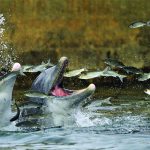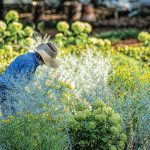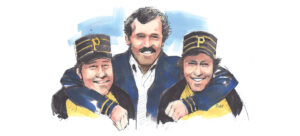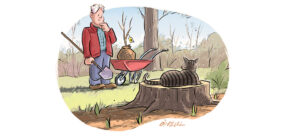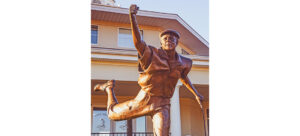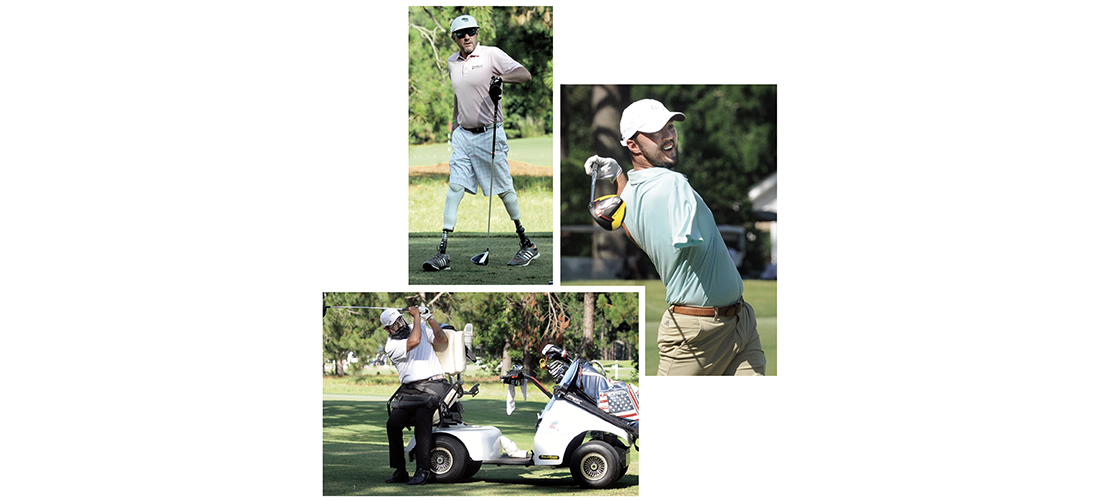
Dare to Dream
The message of the U.S. Adaptive Open
By Lee Pace
Mike Whan, the chief executive officer of the USGA, was talking one morning in late July about the decision to recruit the World Golf Hall of Fame in St. Augustine and move it into 9,000 square feet on the second floor of Golf House Pinehurst, the USGA’s new facility under construction and set to open in 2023.
“It was the right thing to do, the right thing for golf,” said Whan.
Then he quickly drew a parallel with the just-completed U.S. Adaptive Open, which the USGA had conducted the week before on Pinehurst’s No. 6 course. Ninety-six players aged 15 to 80 from around the world played 54 holes of golf. Some played with one leg or no legs. Some with one arm. They played despite having cerebral palsy and muscular dystrophy. They found a way to aim and fire even though some were legally blind.
“The Adaptive Open is the same,” Whan continued. “Certain things you do because it’s the right thing to do. That is one of them. I cannot tell you how much money we lost. It’s a staggering number. But I could not feel better about it because it was the right thing to do for the game.”
Whan said he asked a fellow USGA official for the one word that would best describe the week at No. 6, and the word was “joy.”
“I thought he meant the athletes,” Whan said. “I knew they’d appreciate it and enjoy it. But he actually meant the joy of our own team. This was a 25-year employee of the USGA and he said, ‘Mike, this is a top-two experience.’ I said, ‘What’s the other one?’ He said, ‘Give me a minute. There has to be something.’”
The U.S. Adaptive Open came to fruition after decades of the USGA taking incremental steps to provide more opportunity and awareness for golfers with some degree of disability. In 1991 it announced a grant program for golfers with disabilities. In 1997 it published some modifications to the Rules of Golf to accommodate some of the challenges disabled golfers might encounter. To promote opportunities for golfers with disabilities, the USGA in 1999 partnered with trick-shot artist Dennis Walters, sponsoring his golf exhibitions and elevating the message that having a disability should not keep people from achieving their golf dreams.
And in 2017, the USGA pledged its intent to stage a national championship for disabled golfers. The vision was delayed by COVID-19 until it was announced in late 2021 that the inaugural championship would be held at Pinehurst No. 6 the following July.
“Players in the adaptive space just want to be like everyone else — they just want to be golfers,” said John Bodenheimer, the chief championships officer for the USGA. “We are proud to give them that opportunity. We hope it inspires others in the industry to make the game and its competitions more welcoming to all.”
The golfers came from as far away as Korea, Ireland, Sweden, Belgium, Japan, South Africa, England, and Argentina. Allowances were made for challenges the golfers might have faced. Seated players got four club-length drops from penalty areas and could move the ball 6 inches in bunkers because it could be difficult to find the desired address position in a mechanized scooter. Double par was the max score on any hole.
“When I found out about this, I was intrigued,” Walters said. “It’s a historical event. It’s like 1895 and you’re Horace Rawlins. You’re the first one. That’s why I wanted to be here.”
They were uniformly amazed at the sophistication of the organizational structure — from the bunting and signage around the facility to the volunteer support to a press facility that hosted writers from all the major golf publications.
“This is big time, this is just like the U.S. Open, only smaller,” said Eli Villanueva, a retired Army sergeant from Fort Bragg who plays with a 2-handicap despite an arm impairment. A radial head fracture of his left elbow 30 years ago has left him with limited use of his left arm. Looking around at other competitors, Villanueva marveled at the more severe challenges many have overcome to play golf.
“This is a U.S. Open atmosphere,” he said. “I hope this inspires others. All over the country they’ll see what golfers here have overcome and say, ‘I can do that, too.’ Hopefully it will be the start of more good things to come. An Adaptive British Open? Sounds good to me.”
Two former professional golfers were in the field. Walters was 24 years old and playing the mini tours in 1974 when a golf cart he was driving down a steep incline had brake failure and crashed, leaving him as a T-12 level paraplegic. Ken Green, a five-time winner on the PGA Tour in the 1980s and ’90s, had his lower right leg amputated following a highway crash in 2009. Walters started a traveling trick-shot show that he presents with his dog, Gus, and Green has relearned the game and competed on a sponsor’s exemption in one PGA Tour Champions event and teed it up in the 2019 Senior PGA Championship.
“I am completely captivated and absolutely amazed at what I see,” Walters said. “This is phenomenal. Every one of these people can play golf. They are proving what I have been trying to say for 45 years. I’ve been trying to show, with every swing I make, that golf can be a game for all. This proves it.”
“This is competitive and we’re grinding our tails off,” said Green. “But this is the first event you’ll ever play that if you finish second, fifth or seventh, you’re still walking away smiling. You’ve got an edge in life and that’s what life is about. This is a home run.”
Simon Seungmin Lee, a 25-year-old Korean who was born with congenital autism, won the men’s title with a trilogy of 71s. Kim Moore, a 41-year-old from Michigan who was born without a right foot, a severely clubbed left foot and a slight case of spina bifida, collected the women’s trophy by carding 76-80-76.
“I think what has been seen this week around the world, around the country, is going to elevate the amputee community, the adaptive community, and it’s pretty cool to see,” said Moore.
After the complications arising from the COVID-19 pandemic, Whan said the USGA considered holding off a year or two to give the logistics and protocols more study, but he’s delighted the organization went ahead as scheduled in 2022.
“Sometimes you have to jump off the cliff and not worry about how you splash at the bottom,” he said.
The championship will return to No. 6 again in 2023. After that, the USGA has to decide whether it wants to move it around or establish a permanent home in the Sandhills. No matter, it will have plenty of entries and attention.
“I tell people, have a dream, and if it doesn’t work out, that’s OK. Get another dream,” Walters said.
Green has faced a marriage breakup, clinical depression, financial woes and a son who died of a drug and alcohol overdose. He was driving an RV in rural Mississippi in 2009 when a tire blew, careening the vehicle off the road and killing his brother, girlfriend and dog. He survived but hasn’t had two legs since. The significance of a week in Pinehurst playing in the inaugural U.S. Adaptive Open with 95 other golfers who’d also been dealt a tough hand was huge indeed.
His message to his fellow competitors: Take a bow.
“You were able to pull yourself out of that hole that life gave you,” Green said. “And then you went on to do something really good. You can’t ask for anything more than that. You won both sides of the game — life and golf.” PS
Lee Pace has written for Pinestraw Magazine since 2008 and is the author of eight books about Sandhills golf history and the people who’ve made it special. Write him at leepace7@gmail.com and follow him @LeePaceTweet.

